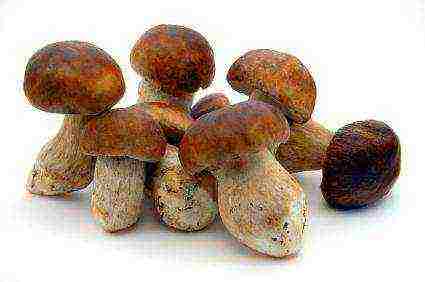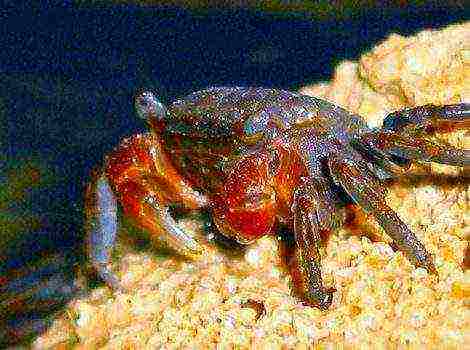Content [show]
It is difficult to find words to describe the emotions and feelings that you experience when you see these amazingly beautiful flowers. Proper cultivation of canna: planting, timely care for it - will allow everyone to enjoy its amazing view and continuous flowering.
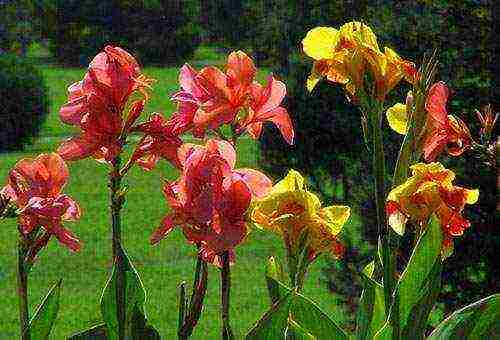
A few words about the plant
Canna is a monoculture, that is, the only representative of the Cannaceae family. Under natural conditions, it grows in South and Central America, China, Indonesia, India.
The flower has thin erect stems that grow in height in some varieties up to 3 m.The leaves are lanceolate or oblong, rather large, can grow up to 80 cm in length and up to 25 cm in width.
Canna reveals its splendor during flowering. The main color of its buds is red, although breeders have managed to breed varieties with yellow, white, orange, pink and even two-color petals - speckled or edged. The flowers grow up to 8 cm, they are bisexual, asymmetrically located on the flower arrow and are collected in an inflorescence - a panicle or a brush.
The flower has only two drawbacks: it does not tolerate our winter in the open field and has no smell. Among its advantages, gardeners distinguish the following:
- very rarely gets sick;
- growing rapidly;
- easy growing;
- easy care;
- decorates the site with its flowering until late autumn.
If the buds have been pollinated by insects, brown large seeds have time to ripen. They can be used for breeding.

Cannes growing methods
The cultivation of the flower comes from seeds or rhizomes, divided in the fall. Sprouting tubers at home or growing a plant from seeds is a must for our climate.
How to grow a canna from seeds
The best time to sow seeds is the end of January or the beginning of February.
Important!
Growing canna in this way is more suitable for breeding work, since seedlings obtained from seeds in most cases do not retain varietal and species characteristics.
In order for the seeds to germinate well, their strong shell must be destroyed. To do this, you can use one of the following methods:
- pour over boiling water;
- hold for 3-4 hours in a thermos with warm water;
- put in the snow for 2-3 hours or in the freezer for 1 hour;
- destroy by mechanical action.
Advice
If you ignore this procedure, seed germination will deteriorate, and the emergence of seedlings will be delayed.
Then the seeds are soaked for 24 hours in a growth promoter and only then are planted in a container with soil, the temperature of which should be at least 22 ºC before sowing. They are sealed to a depth of 7-10 mm, watered, covered with a film (glass). The first shoots will appear in about a month.When 3-4 leaves grow on them, they are dived (planted) in separate pots, in which the flowers are located before planting in open ground.
Advice
After picking, young seedlings are placed in a room where the temperature does not exceed 16-18 ºC.
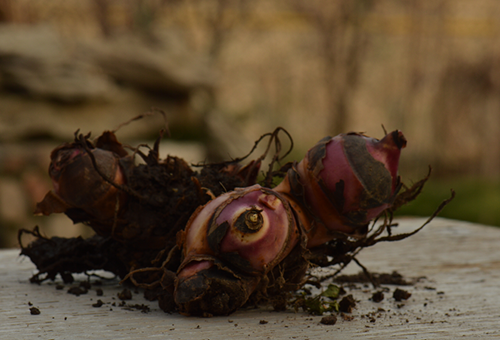
How to grow from rhizome
Growing a flower from a rhizome is considered the easiest and most reliable way. At the end of March or the beginning of April, the stored rhizomes are cleared of the ground, their dried parts are removed. The division is based on the number of tuberous buds. When there are 2 kidneys next to them, they should be left together.
The resulting sections should be treated with a manganese solution diluted in a ratio of 0.2 g of manganese powder per 1 liter of water. For the same purpose, you can take wood ash. Processing is carried out in order to prevent infection of tubers with fungal infections.
The divided rhizomes are planted shallowly in a prepared soil mixture consisting of sand, peat and black soil, taken in equal parts. The first leaves appear quickly - in 2-3 weeks. After their germination, the flower is removed to a cool, but sufficiently lit place with a temperature of 16-18 ºC. Such conditions are necessary so that the young plant does not stretch. Caring for him consists in timely watering and maintaining the desired temperature.
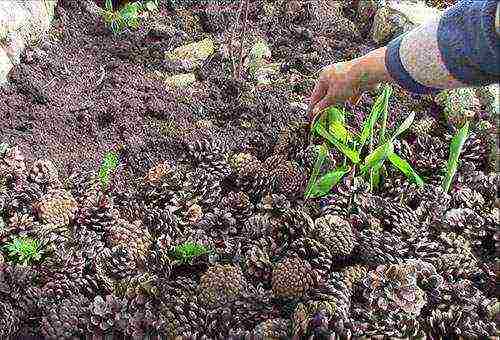
Landing in open ground
If in the spring it is planned to plant a cannes in open ground, then in mid-April it should be taken out and prepared for new conditions for it. To do this, every day in sunny weather it is necessary to take it out into the fresh air.
Planting is carried out after the end of the frost. The flower prefers a sunny area, protected from drafts, with light fertile soil. Before planting, drainage is laid in the hole, consisting of the following components:
- manure or hay (20 cm layer);
- soil (layer 25-30 cm);
- fertilizers.
Such a "pillow" will warm the roots, stimulate the intensive growth and flowering of the canna. You can plant it after intensive watering of the hole. Planting depth - 20-25 cm. The distance between the planted bushes is about half a meter. It usually takes up to 2 months from planting to flowering.

How to care
Further care consists in watering, loosening the soil, combating weeds and feeding.
Leaving involves feeding three times a season. Once every 10 days, when watering, grains of manganese are placed under each flower (or diluted in water in an amount of 2 g per 10 liters of water). It is required to stimulate flowering.
The best types of fertilizers are mineral (containing nitrogen, phosphorus and potassium) and organic.
Their introduction is carried out by the root method: after watering, fertilizer granules are scattered around the bushes, and the soil is loosened. Before flowering, with an interval of 2 weeks, you can feed chicken droppings diluted in water 1:10.
Water the plant regularly, but in moderation. Abundant watering is necessary for a flower only before it blooms.
Important!
When watering canna, do not overdo it. An excess of moisture will provoke the development of bacterial and fungal diseases.
Care includes preserving the decorative appearance of the canna. To do this, she regularly needs to cut off faded flowers.

Growing cannes at home
Growing canna is also possible at home - it is bred as a pot (tub) plant. In order for it to feel good and grow in winter, it is important to know some of the features of its cultivation at home.
In order for a flower to grow at home, it is enough to dig it out of the ground and place it in a pot for indoor plants with a diameter of at least 50 cm, having previously watered the garden soil with an insecticide. Such a procedure is necessary to avoid insects from moving into the premises.
Caring for a plant at home is even easier than in a flower garden. No need to spray it, remove weeds and loosen the soil. It is enough to put in a lighted room, water and feed with fertilizers. The room canna is in a dormant period for only 2 months, and the rest of the time it pleases with its beauty.
Proper and timely home care will preserve the beauty of the canna even after flowering is complete.

Plant after flowering
Indoor canna after flowering needs some rest. It is necessary to reduce watering daily, and then completely stop it. Then the leaves are cut and the pot with the plant is placed in a cool place where the temperature is at least 10 ºC. In the spring, the roots are removed from the soil, divided and planted in pots or open ground.
If the canna grew in the garden, then after flowering it also does not need abundant watering. It gradually shrinks and then stops. As soon as the first frosts begin, the stems are cut off, and the rhizomes are dug up along with the ground.
Important!
Nutrients are localized in the rhizome only after a cold snap. If you dig up flowers before frost, the roots will not receive the supply of substances necessary for wintering.
Before storing cannes, the rhizomes should be dried in the shade for 2-3 days. It is better to lay them out under a shed or in a shed.
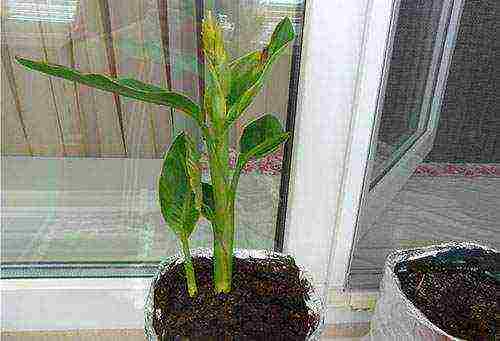
How to store
There are two ways to save the plant until spring:
- in boxes or boxes;
- in flower pots.
If the first option was chosen, then before digging up it is necessary to prepare the soil: mix peat, sand and sawdust in equal amounts. After removing the rhizomes from the ground and drying, they are placed in containers, sprinkled with soil and, if necessary, slightly moistened. The best storage temperature is + 8-10 ºC.
Advice
The entire storage period of the tubers must be viewed. Rotten parts are cut off, sprinkled with charcoal, cinnamon or ash.
With the second storage option, you can simultaneously save flowers until spring and enjoy their appearance in winter at home. The main thing is to have time to dig them up before the onset of frost. Care during this period is slightly different. Cannes should be placed in a lighted place, fed and watered.
If several varieties of canna are put into storage at the same time, it is recommended to attach a tag with its name to each rhizome. This technique will help in the spring when planting to create a unique composition, taking into account the characteristics of each variety.
To grow a flower, it is important for him to create conditions close to his relatives. In summer, it is warm and abundant in moisture, in winter, moderate watering and coolness. The florist's reward for anxious and proper care and patience will be a healthy and strong appearance of the plant, abundant flowering.
Canna (lat. Canna) is a monotypic genus of the Cannova family, the order is gingerbread, has more than 50 species of herbaceous plants. The natural habitat is South America, India, China. Introduced to Europe in the 16th century by Portuguese sailors, but cultivated since the middle of the 17th century. Translated from Greek, the name of the flower means "reed". Indeed, the canna stem is similar to this plant.
The name is translated from Latin as "pipe". An ancient legend says that Cannes grew up on the site of the ashes of a fire in which one Indian chief burned a peace treaty rolled into a wampum - a pipe, which led to a bloody war, and the bright red petals of cannes resemble the flames of that fire and spilled in a cruel war blood. Flower growers appreciate cannes due to its beautiful flowering, large decorative leaves, painted in a dark green, dark purple, red-bronze or even purple hue.
At first glance, it may seem that the canna is an incredible hybrid of a banana and gladiolus or an orchid. The plant has only two drawbacks: in our climate, wintering in the open field is problematic and the flower has no aroma. For the rest - only dignity. Cannes practically do not get sick, are unpretentious, drought-resistant, even beginner growers can cope with them. Cannes will decorate your garden without any hassle, and bloom will last from the end of June until the first frost.
Description of cannes
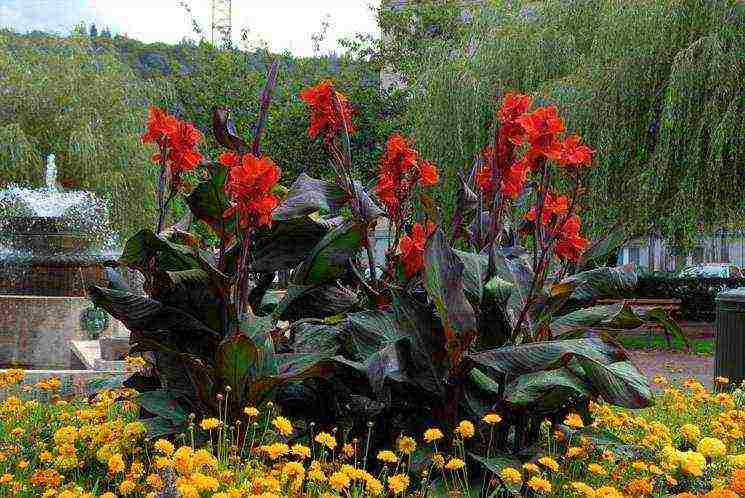
How to care for a canna in the garden photo
The root system of the canna is branched, it grows in breadth.Peduncle stems are thick, high (from 60 cm to 3 m), erect. The leaves are powerful, large, pointed, reach 25-80 cm in length, 10-30 cm in width, the leaf shape is oblong or elliptical, the leaf plate is smooth. The stems and leaves are colored deep green. The color and shape of the leaves already makes the plant attractive, but when it blooms, you will see beauty and harmony.
The flowers are dioecious, sharply asymmetrical, the size is 4-8 cm, the original color is red, but varieties of yellow, pink, orange, bicolor, speckled, with a border have been selectively bred. Even white cannes are very rare. Flowers are collected in racemose or paniculate inflorescences. After flowering, the fruit is formed in the form of a three-celled capsule.
Growing cannes from seeds
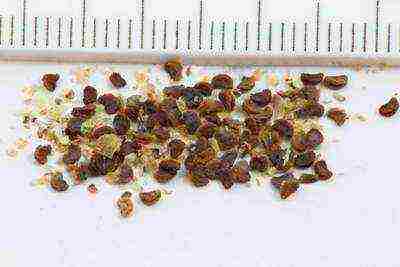
Cannes seeds photo
Cannu can be propagated by seeds and vegetatively. When propagated by seeds, varietal differences can be lost, especially since not all varieties are tied to the seeds, the ideal breeding method is to divide the rhizome. But if you are interested in breeding, you can try planting seeds. The seeds have a very hard shell, which must be softened before sowing. You can scald the seeds with boiling water and hold them in warm water in a thermos for 3-4 hours, or hold them on a hot battery for 12 hours.
You can act with cold - freeze in the refrigerator for a couple of hours. Seeds are sown in February. Use a lightweight soil (for example, a universal peat-based substrate in a 1 to 2 ratio). It is better to sow each seed in separate containers, peat pots are ideal. The soil must be moistened, the seeding depth is 2 cm. Cover the crops with foil and place in a well-lit place, maintain the air temperature at 22-23 ºC.
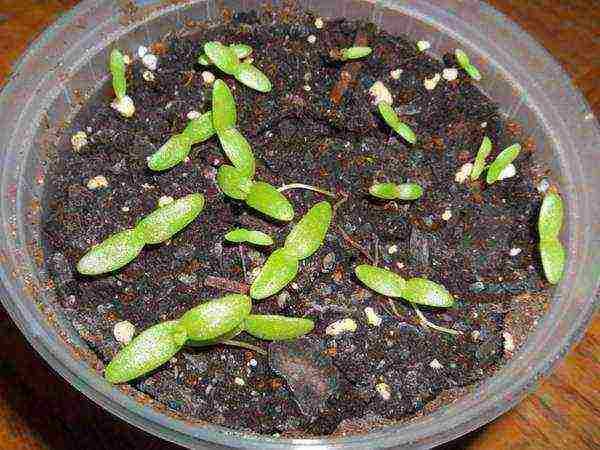
Canna seed photo shoots
Seedlings will appear in 3-4 weeks. When the first sheet appears, the film must be removed. Seedlings need good watering, regular fertilizing with complex fertilizers and periodic spraying. In early summer, the seedlings can be taken out to the greenhouse and kept at 16 ºC until they are planted in the garden. Healthy seedlings should have 3-4 leaves and reach a height of about 20 cm. You can plant them in open ground when the threat of even the slightest frost has passed. Plants from seeds will bloom the following summer.
Canna propagation by dividing the rhizome

How to reproduce cannes photos
The most reliable way to get flowering in the same year is to propagate the plant by dividing the rhizomes (tubers). Do this in March or early April. Each section is a separate tuber, if they are located very close to each other, then it is better to leave both. Treat the cut site with a weak solution of potassium permanganate or crushed coal. It is better to grow tubers in boxes of sand.
The bud (tuber) is placed horizontally, sprinkled with sand, from time to time sprayed with warm water. Germinate at a temperature of 20-24 ºC, you can slightly warm the soil from below. When the buds germinate and the first leaf appears, provide good lighting and an air temperature of 16ºC. Water every 10 days with a weak solution of potassium permanganate (2 g per 10 liters of water). The appearance of yellow leaves indicates a fungal infection - increase the concentration of manganese. You can do without growing, but when planted directly into the soil, the cannes may not start or bloom this year.
When and how to plant cannes in the garden
- With the retreat of spring frosts, you can begin to prepare a place for planting cannes.
- It should be a sunny area, protected from drafts, the soil needs fertile, warm, rich in organic matter.
- The needs of the flower are similar to the vegetable crop of the cucumber. The optimal composition of the soil is considered to be a mixture of humus, leafy soil, coarse sand and peat in equal proportions. Be sure to provide good drainage.
- Experienced flower growers recommend planting cannes after May 9th.From a possible sharp temperature drop, the canna can lag behind in growth for a long time, respectively, the flowering period will be delayed or not at all.
So, when the threat of frost passes, and the earth warms up to 8-10 ° C, you can plant cannes in open ground. To get the most out of the plant, make a warm bedding for it: at the bottom of the planting hole, about 50 cm deep, lay a 15-cm layer of fresh manure or any organic matter that will give the roots warmth and provoke intensive growth and good flowering. Next, a 25 cm layer of soil is poured. Moisten well and place the canna rhizome in the hole, dig in. If the tuber has not sprouted, then the planting depth should be 6-9 cm. There should be a distance of 0.4-0.5 meters between plants and rows. Canna should bloom about 1.5-2 months after planting.
How to plant cannes, we look at the video:
Canal garden care: watering, diseases and pests
During the growing season, cannes need to be fed a couple of times with mineral fertilizers. Do it this way: after watering, scatter granules around the plant and loosen the soil. For 1 m2, 40-50 g of a mixture of fertilizers is needed (10 g of potash + 12 g of nitrogen + 25 of phosphate).
Watering should be done regularly, but in moderation, until shoots appear. With the formation of flowers, watering must be intensified, but waterlogging must not be allowed, because fungal or bacterial diseases can occur, fraught with blackening and death of the buds. After flowering, watering is gradually reduced, and then completely stopped.
The succulent canna leaves are to the taste of the caterpillars, and the rhizome can damage nematodes. Insecticides will help in the fight against them.
Faded inflorescences need to be cut off. Remove weeds, especially in the first half of the growing season. To protect the root necks of the canna from freezing, immediately after the end of flowering and before the onset of frost, they need to be spilled high. After the first frost, cut off the stems of the plant at a height of 15-20 cm, dig out the rhizome together with an earthen lump.
How to store cannes in winter
When to dig a cannu
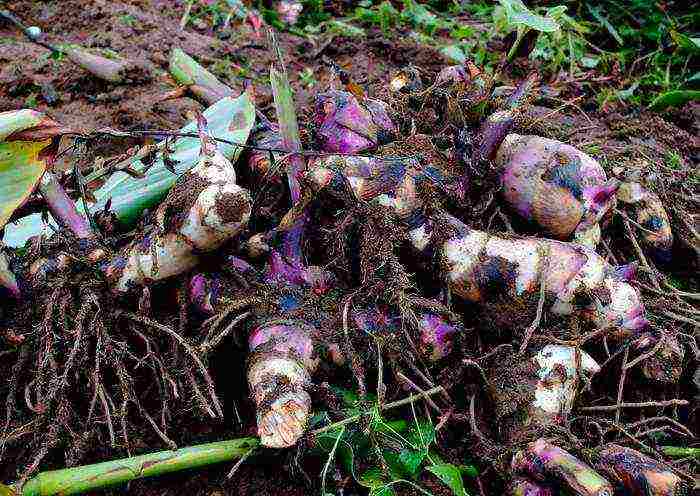
When to dig cannes and how to store in winter
How to save Cannes for the winter? Cannes are usually dug up in late September or early October and transferred to storage until spring. Best stored in a cool place with ambient light and moderate humidity. Fold the rhizomes in boxes, sprinkle with sand, peat and non-coniferous sawdust. The moisture content of the soil should be about 50%, and the temperature around + 6-8 ° C. Regularly inspect cannes rhizomes for decay. If you find a tuber infected with rot, cut it to a healthy area, be sure to treat the cut with iodine. Protect tubers from extreme temperature changes.
Cannes in winter in an apartment
If there is no special room, you can store the tubers in the refrigerator. Dig up the roots in the fall, rinse under running water from the ground, hold for 24 hours in a disinfectant solution of manganese (very weak, pink), dry well, wrap each tuber in paper and put in a container designed for storing vegetables. Also check periodically for rot.
You can store dried cannes roots on the balcony: place them in a plastic bucket and sprinkle with dry earth. In severe frosts, you need to bring a bucket into the apartment, the tubers should be laid out under the balcony door on the floor.
The rhizome can still be stored in the potting soil, keeping the temperature up to 15 ºC. You can put the pot on the veranda, attic or glazed loggia. Moisten the soil a couple of times a month. In warm regions without frosty winters, you can dig up the rhizomes of the cannes and store them on the site, avoiding flooding with water and protecting them from the wind. Cover the tubers with dry sawdust in a layer of 20 cm.
Home canna: how to care for a flower at home

Ampel canna Cleopatra Cleopatra photo
Cannu can be successfully grown in pots or tubs. This applies to species and varieties that can fit in a house, apartment, balcony or terrace.Due to its decorativeness, the indoor canna will become a real center of the flower arrangement of your winter garden. A home canne has enough rest period for two months, and the rest of the time it will delight you with gorgeous foliage and bright flowering.
Care and proper watering
Cannu is grown at home like any other houseplant. In the fall, you can dig a garden canna, the soil around the plant should first be watered with an insecticide in order to destroy insects and not bring them into the house, transplant the canna into a pot or tub with a diameter of 0.5 m.
It is easier to care for a canna at home than in gardens. There is no need to spray, control weeds, feed and loosen the soil. Give it a place with good lighting, water it with softened, settled water as needed, occasionally wipe the leaves with a damp soft cloth or sponge. After flowering, the leaves will remain bright and delight with beauty.
Dormant period
When the home canna needs rest - after flowering - gradually reduce watering until it stops. Cut the leaves at a height of 10-15 cm from the root, transfer the pot to a cool dry place, the temperature should be at least 10 ° C.
In the spring, the rhizome is removed from the pot, the tubers are divided and planted. You can plant them in pots or in the garden.
Types and varieties of cannes with names and photos
Canna Indian Canna indica or Canna fiorifera

Canna Indian Canna indica or Canna fiorifera
The progenitor of almost all types of cannes. The cultivated varieties of Indian cannes obtained as a result of selection are called garden canna. These hybrids are classified into three groups.
Cannes Crozi (french cannes)
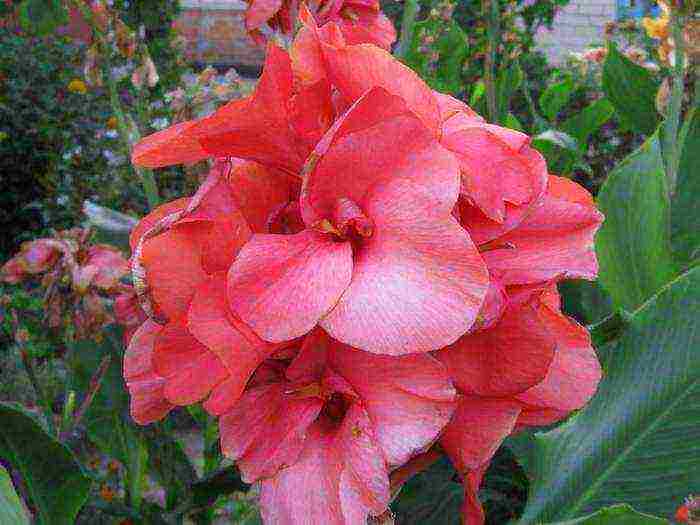
Canna garden variety Livadia photo
They are considered dwarf species (60-160 cm), their flowers are similar to gladioli. The dark green or purplish pink leaves are covered with a white donned.
Varieties:
- Livadia: up to a meter in height, red-crimson flowers appear on a peduncle 25-30 cm long, petals have a limb, begins to bloom in July;
- America: 120-140 cm high, blood-red flowers 12 cm in diameter, inflorescence length 30-35 cm, purple leaves, blooms in July;
- President: up to 1 meter high, bright red flowering on a peduncle 30 cm high, the color of the leaves is standard - green, from July it begins to bloom.
Orchid cannes
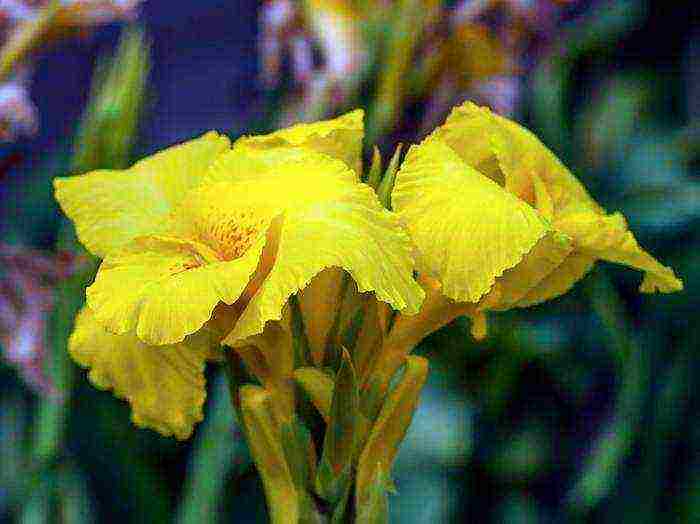
Canna yellow suevia kanna suevia photo
A tall species with a height of 1-2 m. The flowers are large - 12.5-17.5 cm with thin corrugated edges, resembling Cattleya in shape. The leaves are green, may have a purple tint.
Varieties:
- Andenken an Pfitzer (Andenken an Wilhelm Pfitzer): 110-140 cm high, the inflorescence reaches a length of 30 cm, the color of the flowers is bright orange with red strokes, the leaves are brown-purple, begins to bloom in July;
- Suevia: up to a meter in height, lemon-colored flowers 12 by 15 cm in size appear in mid-July, leaves are green;
- Richard Wallace: height about one meter, flowers are light yellow in color with a red speck, the length of the inflorescence is 20-25 cm, blooms in July.
Deciduous (small-flowered) cannes
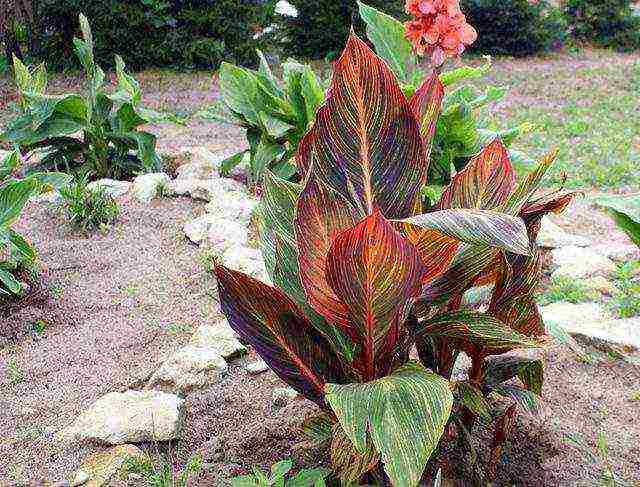
Canna durban photo Growing in the garden
They grow up to 3 m in height, the leaves are very beautiful, painted green, purple, violet-green, small flowers - no more than 6 cm in size, this species is rarely grown in culture.
Durban is the most famous small-flowered canna variety. The flowers are yellow-orange, the color of the leaves is more interesting - in a pink-yellow-bronze-green strip.

Canna Alberich Canna Alberich photo
Cannes is a lovely exotic flower. They have an unusual shape, bright color and a chic frame of succulent wide leaves. These perennials are native to warm tropical countries. Despite this, even in the harsh Russian climate, you can see how cannes decorate the most beautiful flower beds and lawns.
Cannes seeds have a fairly hard shell, for this reason, they must be softened before planting. This can be done by freezing for 2 hours or vice versa - place the seeds in boiling water for 3-4 hours.In February, you can sow prepared seeds in light, loose soil. There should be no bright lighting, and the temperature is 22-23 degrees.

A month later, the first fragile shoots will appear. When the first leaves are formed on the seedlings, at least 3-4 pieces, you can transplant them into separate pots. Cannes sprouts will remain there until the end of May. Then you can transplant them to a flower bed. The first blooms will appear only next year, but some plants can please with flowers this season.

In order to save time and effort, as well as to achieve the best results, cannes are most often propagated by tubers. The rhizomes are divided in such a way that 1-2 good buds are located on each tuber. The cut on the tuber is treated with crushed coal and dried a little. Preparation of the soil should be started when the ground has already warmed up, becomes soft, and the threat of frost has passed.

Cannes are not particularly whimsical flowers, but the most optimal soil for them is a mixture of sand, peat and humus. The place for the flower bed should be sunny and, if possible, protected from the wind. Cannes tubers are lowered into the ground to a depth of 7-10 cm and at least 50-60 cm apart.
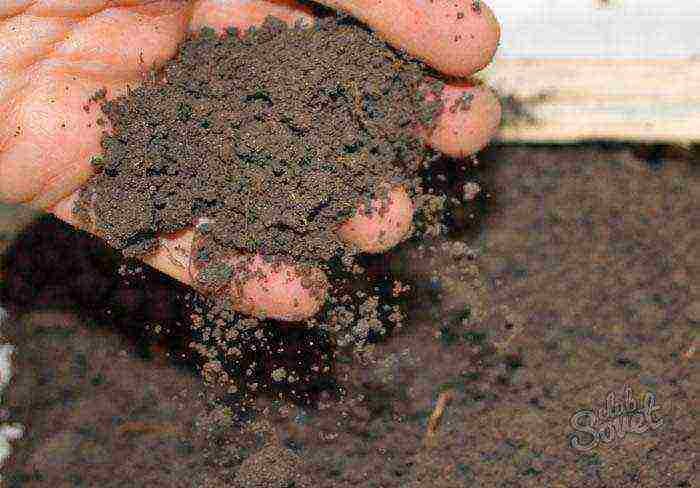
If there is no confidence in the fertility of the soil, then it makes sense to make a manure lining. To do this, you need to dig a hole about 50 by 50 cm and 50-60 cm deep. Fresh horse manure with a thickness of 20-25 cm is placed on the bottom, watered and covered with earth. The gradual rotting of the manure will provide nourishment and warmth to the roots, which will ensure a lush and abundant flowering.

Until the first shoots have sprouted, the land must be fertilized several times with mineral fertilizers and moderate watering must be provided. During the flowering period, more abundant soil moisture is required. And by September, when the flowering subsides, the amount of water is gradually reduced.

Before the onset of the first cold weather, the faded cannes are huddled high in order to protect from bad weather. And as soon as the time of frost has come? the stems are cut and the tubers are dug up along with a little soil for winter storage. It is best to hibernate cannes in a box or box, sprinkled with earth, peat and sawdust. The temperature should be 5-8 degrees and humidity 50-60%.

Another option for storing rhizomes is to put them in the refrigerator. After the tubers have been dug up, you need to carefully clean them from the ground and rinse under running water. Then for an hour soak in a weak solution of potassium permanganate for disinfection. And when they are dry, carefully wrap each root in paper and put away in the vegetable section of the refrigerator.

At home, these wonderful flowers feel no less comfortable than in the garden. Cleaning in an apartment is even easier than on the street, as there is no wind, weeds and parasites. It is enough to provide a sunny place, watering as needed and sometimes wipe the wide cannes leaves with a damp cloth.

Homemade canna will delight with flowering longer than its street relatives. The growing season will only take a couple of months. When flowering comes to an end, you need to reduce watering, bringing it to zero. After that, cut off the dry leaves, leaving a stump 10-15 cm in height. In this form, the pot is removed to a dark, dry place with a temperature of 10-15 degrees. In the spring, you can dig up the tubers, and after dividing them, plant them again on the windowsill or transfer them to the garden.

Canna flowers have a wide range of colors. You can often see how they are the central decoration of flower beds near high-ranking buildings and institutions. These plants have only one drawback, or rather even a feature. For all their beauty, these flowers are completely odorless.
Cannes belong to the multi-type canna family. Their genus has more than fifty species. In nature, they can be found in countries such as India, South and Central America, and China. In European countries, these flowers appeared in the sixteenth century. They were brought here by Portuguese sailors.Growing cannes in the garden will provide you with not only beautiful, vibrant flowers, but also large decorative leaves that are appreciated among flower growers. In this article, we will consider all the features of this plant and the rules for caring for it.
general characteristics
Before you start growing a canna flower, you need to find out its main characteristics. This plant has an original appearance: its leaves resemble a banana, and the inflorescences can be easily confused with an orchid or gladiolus. It practically does not have any drawbacks, however, when cultivated in our latitudes, the flower has absolutely no aroma, and it also does not tolerate our winter in the open field. But the advantages will have to list for a long time.
First of all, it is, of course, the beautiful appearance of the plant. Not only bright inflorescences stand out, but also wide green leaves. Canna will become a decoration of any garden, and its flowering will delight you from the beginning until June until the first frost. Many growers are accustomed to the fact that such beautiful plants are very whimsical, but this stereotype is completely inapplicable in relation to cannes. She is absolutely not afraid of drought and does not require any special care.
The plant has a fibrous root system, which grows very rapidly. The flower-bearing stem can reach three meters in height. Beautiful and large leaves are elliptical, slightly pointed at the end. They can reach eighty centimeters in length and thirty in width. Especially appreciated in flower shops and are used to create beautiful flower arrangements. The flowers are asymmetrical and initially were only a red hue, but the breeders did not sit still, and now you can admire the inflorescences with a variety of shades and sometimes not even monochromatic. And after the end of flowering, you can find a three-nested box on the stem, which is both a fruit and a seed.

Variety of varieties
- Canna is Indian. This is the first canna to appear in our gardens. Now it is called the garden. As a result of many years of work by breeders, many different subspecies of this variety have appeared, which we will talk about later.
- Cannes Crosey. This is perhaps the shortest variety, the maximum height of which is no more than one and a half meters. During flowering, some confuse it with gladiolus, and indeed, apart from wide leaves, there is no particular difference between plants. This species was bred back in 1868 by one French breeder, and this variety now bears his name.
- Orchid cannes. This variety is tall. The corrugated edges of large flowers resemble orchids in color and it is not difficult to guess where this name came from.
- Deciduous cannes. They are the tallest plants with very beautiful green or purple leaves, but they have rather small flowers. Florists rarely breed just such a variety.

Seed propagation
In this section, we will try to make out whether it is possible to grow canna from seeds, and how effective this method is. In general, gardeners are not very fond of planting cannes in a seed way, since it is not always possible to find boxes with seeds on a plant, and they do not always retain varietal characteristics. Inexperienced growers choose such a method as dividing the rhizome. However, for those who are fond of breeding, the seed propagation method may seem very interesting.
The seeds of this plant are distinguished by a very hard shell, which must be softened before planting in the ground, otherwise you can not count on seedlings. To do this, you need to scald the prepared seeds with boiling water and leave them in this water for several hours, placing them in a thermos. But if you do not have a thermos or time, then you can simply put them on a hot battery for twelve hours. But you can soften the shell not only with the help of high temperatures, but also by placing the seeds for a couple of hours in the freezer.
Seeds are planted in the ground in February, at an air temperature of at least 23 degrees. Try to keep the room dark. The first shoots can be observed after 3-4 weeks. When four leaves appear on them, you can safely dive and plant in different pots. Now the air temperature in the room should not exceed sixteen degrees. Cannes (flowers) stay in such conditions before growing in the open field. Some seedlings will be able to please you with their flowering this year, but many will still do it only next summer.
A more reliable way of breeding canna is considered to be the division of the rhizome. This process is best done at the very beginning of March. Large tubers need to be divided into several parts so that each piece has one large kidney or several small ones. Places of breaks should be sprinkled with crushed coal and left to dry for a while. All tuber particles must be put, tightly pressed against each other, in a special greenhouse container, directly on the ground or sand, and then lightly sprinkled with sand and sprinkled with warm water from time to time. Make sure that the kidney is horizontal. Until you notice the first shoots, the air temperature in the room should not drop below twenty-four degrees. It is good if the container is heated from below.
When you notice that the seedlings are cramped in the container, they need to be planted in different pots. Now for the canna, the growing conditions should change, or rather the air temperature should be lowered to sixteen degrees. In order for the seedlings to grow stronger, once a decade they need to be watered with a solution of potassium permanganate. To prepare it, you will need 10 liters of water and two grams of manganese. You can bypass the period of keeping tubers at home and go straight to growing cannes in the garden. But in this case, it is unlikely to bloom this year.

When to plant cannes (flowers)
Outdoor cultivation begins with soil preparation. You can start this process as soon as the night frosts stop. Be very responsible when choosing a place for a plant. Further flowering depends on this. Canna should grow in a draft-free area, fertile and warm soil, and sufficient sunlight. The composition of the soil should include:
- leafy land;
- humus;
- peat;
- coarse sand.
All these components must be contained in equal parts. And don't forget to provide good drainage. But it is better not to start planting seedlings earlier than May 9. This is due to the fact that in spring the air temperature changes quite often. And from the heat of the day nothing may be left in the evening. Such changes can have a very detrimental effect on the plant and slow down not only its growth, but also flowering. Growing cannes outdoors can be very difficult.

Disembarkation process
We have already decided on the landing period, now we need to study the disembarkation process. Prepare the landing pit in advance. Its diameter should be 50 centimeters. The bottom must be covered with a layer of manure of at least 20 centimeters. This is necessary so that the roots of the plant are always warm, even during severe winter frosts. But do not forget to sprinkle the manure with a layer of earth so that the roots do not "burn out". Planting seedlings can be started only after preliminary moistening of the laid out layers of manure and soil. The rhizome is dipped into the hole and sprinkled with earth. If you decide to plant non-sprouted tubers, then do not deepen them more than nine centimeters. The distance from flower to flower and from row to row should be at least half a meter. From the moment of planting to the first inflorescences, no more than two months pass under optimal conditions for the development of the plant.
Care in the garden
For canna, growing conditions do not have any peculiarities, however, some rules should be remembered by every gardener.First of all, the plant needs feeding during the growing season. This procedure can be carried out two or three times. To do this, you need mineral fertilizer granules, which you can buy at a specialty store. They are simply sprinkled in the root zone, and then the soil is well loosened. And you can also prepare a mixture of fertilizers, which will positively affect the flowering process and the development of the entire plant. To do this, for one square meter of land you will need a mixture that includes:
- ten grams of potash fertilizer;
- 12 grams of nitrogen;
- twenty-five grams of phosphorus.
All other points that relate to canna, care and cultivation for it, do not have any peculiarities. Watering should be done regularly, but not too often. With the appearance of the first shoots and the beginning of flowering, moisture should be more frequent, however, try not to flood the plant, since too much moisture can lead to the development of various diseases. And fungal and infectious diseases lead to blackening and even death of the buds. Among insects, caterpillars of butterflies, which damage the leaves, are especially dangerous, as well as nematodes, which are especially detrimental to the root system. Insecticides are most effective in combating these pests.
After flowering is complete, it is imperative to remove the faded buds. During the growing season, make sure that various weeds do not appear in the root zone, and if present, be sure to remove them. When flowering is completely over and nature begins to prepare for winter, the cannes need to be spud, and quite high, in order to protect the root collars from freezing. At the beginning of the article, we talked about the fact that this plant is afraid of severe frost.

Growing cannes at home
Cannes can be found not only in a beautiful garden, but also on the grower's windowsill. But not every variety can fit on your window or balcony, so you need to be especially vigilant in this matter. Homemade canna, which is grown in the winter garden or on the terrace, blooms almost all year round. She only needs two months to get some rest. You can immediately plant the canna in a pot and place it on your windowsill, or you can transplant it from the garden in late autumn to extend the summer in your apartment. But remember that when transplanting a garden plant, you need to prepare a pot in advance, the diameter of which should not be less than fifty centimeters. And an especially important point is that you need to pre-treat the soil from the garden with insecticides. This will be a prophylaxis against insects that can penetrate your house along with the plant and affect all indoor flowers.

Care in the apartment
It is much easier to care for a canna at home than in a garden, although the process is not too tedious there. It is enough just to put a pot with a flower in a place that is well lit, and also water it on time. Periodically, you need to wipe the leaves with a damp cloth. Do not forget to prepare the water for irrigation in advance so that it has time to settle. You will not have to carry out any other actions. At home, even after the cessation of flowering, the leaves of the plant remain the same beautiful and bright.
After flowering
Homemade canna is fading and needs rest during this period. The owner's task is to gradually reduce the watering of the plant, and then completely stop. After that, the leaves must be trimmed at a height of ten centimeters from the base. The pot with the prepared plant should be placed in a dark, cool place where the air temperature should not be lower than ten degrees. With the onset of spring, the rhizome is removed from the pot and divided for the purpose of reproduction. You can plant the resulting delenki in other pots or take them out into the garden to plant flowers on the street.
As for growing canna flowers in the garden, they also need to be watered as little as possible after flowering, and then spud, as described earlier in the article. With the onset of the first frosts, the rhizome, together with the earthen lump, is taken out of the ground, and the stems are cut off by twenty centimeters.

Winter period
In the middle of autumn, the dug out cannes, together with a lump of earth, are transferred to the place where they will "wait out" the winter. To do this, it is better to choose a room where there will be diffused light, cool and moderately humid air. Rhizomes are placed in special containers and sprinkled with a special mixture of peat, earth with sawdust and pine needles, as well as sand. This substrate should have a temperature of at least eight degrees. But do not forget that you have canna stored somewhere. Check your rhizomes regularly as they can develop rot. If such a problem is found, the affected area should be cut off, and the place should be treated with an iodine solution. In addition, the level of humidity and temperature should be under constant control. The changes can be detrimental to the rhizomes.
In cases where there is no storage space, you can do this in the refrigerator. The tubers need to be dug out, washed, dried and wrapped in paper each separately. But also do not forget to monitor the appearance of rot and get rid of it in time.
